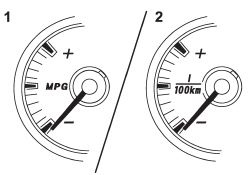ECO gauge

1) U.S.-spec. models
2) Except U.S.-spec. models
The ECO gauge shows the difference between the average rate of fuel consumption and the current rate of fuel consumption. Using the average rate of fuel consumption since the trip meter was last reset, the indicator needle behaves as described in the following items.
U.S.-spec. models:
If the current rate of fuel consumption is lower than the average rate of fuel consumption, the indicator needle points to the У+Ф side. If the current rate of fuel consumption is higher than the average rate of fuel consumption, the indicator needle points to the У−Ф side. When the indicator needle is pointing to the У+Ф side, it indicates fuel-efficient driving.
Except U.S.-spec. models:
If the current rate of fuel consumption is lower than the average rate of fuel consumption, the indicator needle points to the У−Ф side. If the current rate of fuel consumption is higher than the average rate of fuel consumption, the indicator needle points to the У+Ф side. When the indicator needle is pointing to the У−Ф side, it indicates fuel-efficient driving.
NOTE
● The ECO gauge shows only an approximate indication.
● After resetting the trip meter, the average rate of fuel consumption is not shown until driving 0.6 mile (1 km). Until that time, the ECO gauge does not operate.
See also:
Examples of the types of accidents in which the SRS side airbag and SRS
curtain airbag will basically not deploy.
1) The vehicle is involved in frontal collision with another vehicle (moving or stationary).
2) The vehicle is struck from behind.
The SRS side airbag and SRS curtain airbag are basically not desi ...
Examples of the types of accidents in which the SRS side airbag is unlikely
to deploy.
1) The vehicle is involved in an oblique side-on impact.
2) The vehicle is involved in a side-on impact in an area outside the vicinity of
the passenger compartment.
3) The vehicle strikes a tel ...
Meter/Gauge needle illumination setting (turbo models except STI)
When the setting is activated or deactivated, the meter needles and gauge needles illuminate and turn off as follows.
Activated:
When the driverТs door is opened while the ignition switch is in the ...


